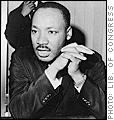
I Have A Dream
This upcoming weekend marks Martin Luther King Day, and for those interested in paying respect, or in visiting any of the key scenes of his life, here is a short and selective biography of the civil rights leader, focusing on real, Road Trip-worthy places (and a few web sites) where you can get a sense of his admirable life and troubled times.
Martin Luther King, Jr was born on January 15, 1929, in the “Sweet Auburn” section of Atlanta Georgia. His birthplace has been evocatively restored, and the surrounding neighborhood includes his family church and the King Center for Non Violent Social Change, where Dr King is interred.
Following in the politically active footsteps of his father, Martin Luther King Jr. joined the NAACP and became a Baptist minister, after attending Morehouse College and Boston University, where he got his PhD (hence the title "Dr."). In 1953, at the age of 24, he accepted his first pastorship, at Dexter Avenue Baptist Church in Montgomery, Alabama. Here Dr King first came into the public eye, helping to maintain the year-long bus boycott that followed Rosa Parks’ legendary refusal to move to the back of the bus.
Despite numerous death threats and assaults, Dr. King continued to campaign fearlessly and peacefully for justice and civil rights, most famously at the August 1963 March on Washington for Jobs and Freedom, where Dr King delivered his unforgettable “I Have a Dream” speech to a crowd of 250,000 supporters. In 1964 Dr King was awarded the Nobel Peace Prize, at age 35 its youngest-ever recipient. The next year found Dr King back in Alabama at the heart of the struggle to secure voting rights, as he helped lead a march to the state capitol in Montgomery from Selma, where local activists had been battling to increase the political representation of the black majority population. Selma is a great place to get a sense of the Civil Rights struggles, home to the National Voting Rights Museum and an icon of the times, the Edmund Pettus Bridge where the Civil Rights marchers were brutally attacked by racist mobs. The entire route between Selma and Montgomery is now preserved and interpreted as a National Historic Trail.
Despite the increasing violence of the later 1960s, Dr King maintained his non-violent approach, moving into a low-income section of Chicago to highlight the fact that racial inequality was not solely a concern of the Deep South. Increasingly involved in protests against the Vietnam War, Dr. King continued to support efforts to obtain racial equality, and in March 1968 came to Memphis in support of black sanitation workers on strike for equal pay. The day after giving a prophetic speech anticipating his own death, on Apreril 4 1968 Dr King was assassinated at the Lorraine Motel, which now houses the National Civil Rights Museum.
As with the Kennedy assassinations, Dr King’s death has generated reams of conspiracy theories, but on the anniversary of his birth I prefer to focus on his contributions, to which I hope this brief blog does some justice. So, while you’re enjoying the day off school or off work, I hope you can take another moment or two to think about Dr King’s legacy, and maybe plan a trip to visit some of these emotionally-charged, history-rich places.

1 Comments:
There is a beautiful memorial to Dr. King at the Yerba Buena gardens in San Francisco. It's often overshadowed by the amazing Art Museum across the street but a walk through the memorial - especially if the waterfalls are on - while reading his words is a very moving experience. The sound of the water rushing past while you absorb the meaning is powerful. While the events took place in a certain time period (and I'm old enough to remember them) you get the sense of the timelessness of the never ending struggle against hatred and injustice.
I think you'd like this memorial.
Post a Comment
<< Home